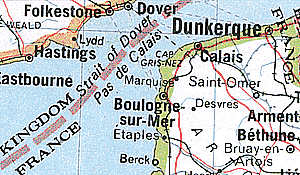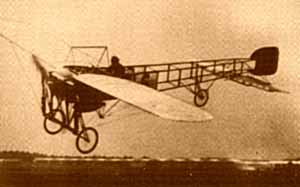 That twenty three miles is about the same distance as from Calais,
France to Dover, England across the English Channel.
That twenty three miles is about the same distance as from Calais,
France to Dover, England across the English Channel.

All pilots with a single engine land rating have at one time or other had occasion to fly over large bodies of water. I don't mean like Newburgh Lake or other such puddles. I mean water--- Lots of water. For instance like taking the shortcut route to Put-In-Bay across Lake Erie, or across the lake to Oshkosh. Orlo Maxrield once made that trip the hard way,--- he zig-zagged across. Any way you do it theres always an element of danger, added anxiety, extra pressure, and of course the engine always seems to run just a little rougher then. Any or all of these make for a less comfortable ride. The very thought of having to swim to the nearest shore should something unforseen happen is enough to question your reason for being in this situation. I remember that feeling the day I flew across to Beaver Island up in northern Lake Michigan. That distance from the nearest shore is about 23 miles and even at 100 mph it seems to take forever. Forty five hundred feet didn't seem high enough over all that wet stuff below.
My first approach from the south into Grosse Ile over the water
banking in to line up on runway 35 made me feel like a Navy pilot
coming in for a carrier landing. Fortunately the runway was long and
there was no net at the end to stop me.
 That twenty three miles is about the same distance as from Calais,
France to Dover, England across the English Channel.
That twenty three miles is about the same distance as from Calais,
France to Dover, England across the English Channel.
Twenty three miles of rough, wild, open sea. How many of us would be willing to make the trip in a plane we built? A plane so fragile that it had to takeoff only into the wind and no more than 5 mph velocity. An engine that lacked sufficient power and was very unreliable. And to make the flight at about 250 feet above the water.
Well, a Frenchman named Louie did it, and this took place less than six years after the first flight of the Wright Brothers at Kitty Hawk.
This, of course, was Louis Bleriot and the date was July 25, 1909. He took off from Calais heading west toward England. The tiny monoplane struggled to stay airborne. Its broad chord wing only 25' from tip to tip and heavily cambored and wire braced from a center king post. It employed wing warping for lateral control. The fuselage an open lattice-work frame with snap-on covers extending back to just aft of the open cockpit. The bicycle wheels sprung on rubber bungee cords and attached to big box frame that was the landing gear. The three cylinder engine whose barrels are arranged in a fan shape and is supposed to produce about 25 hp. Lubrication is by a total-loss castor-oll system pressurised by a rubber bulb in the cockpit. Total loss is a misnomer, for the oil is not so much lost as sprayed in a vaporized haze all over the unfortunate pilot, who also suffers from blurred vision from the engine's vibration. Part way across the channel the motor began to overheat and only a fortuitous rain shower cooled his cylindere and prevented a ditching. A fate which had twice befallen his close rival, Hubert Latham. Louie completed the trip in 37 minutes and landed near Dover Castle. Everyone was inspired by the triumph, except perhaps the customs official who insisted on examining Mr. Bloriot's vessel for signs of contraband or contagious disease, This flight time was almoet certainly the longest period for which an Anzani engine had until then run uninterrupted.
 When news of this remarkable flight reached the English people, they
were outraged, "Briain is no longer an island," the press proclaimed.
Not since 1066 had the arrival of a Frenchman on Brittish soil been of
such epoch-making significance.
When news of this remarkable flight reached the English people, they
were outraged, "Briain is no longer an island," the press proclaimed.
Not since 1066 had the arrival of a Frenchman on Brittish soil been of
such epoch-making significance.
The French on the other hand were ecstatic. Louie was their hero, a conqueror. He was decorated by the president of France with the French Legion of Honor. He was also a good businessman. He had made his fortune manufacturing acetylene lamps for motorcars, and blew nearly all of it dabbling with flying machines. He tried every conceivable configuration before settling on the monoplane layout which today remains the most popular form, apologies to Burt Rutan, wings at front, tail at the rear. He first featured the logical system of control adopted by all planes to this day. The control wheel turning for wing up or down, fore and aft for up or down and the rudder pedals for directional turns.
Within two days of the flight, orders for more than 100 machines flooded in and soon his monoplanes were in widespread use at training schools and in military service throughout the world.
Why did Louie attempt such a daring flight though he had only five hours of flying experience at the time? Why, for the best reason of all: Money. Lord Northcliffe, a London newspaper baron offered a prize of 1000 English pounds to the first person to fly across the channel non-stop in an aeroplane.
We must remember that aviation was still in its infancy. Any flight was a dangerous undertaking. Structures failed, engines quit constantly and flight duration was measured in minutes rather than hours. There were only 14 flights up to that time that exceeded an hour. Wilbur Wright managed to fly 2 hours and 20 minutes just six months earlier.
Bleriot's accomplishments in both flight and design were so important that in 1936 the Federation Aeronautique Internationale (FAI), an organization that records all world record flights in speed, altitude and duration, created a special medal in honor of Louis Bleriot "the great aviator pioneer and former vice president of the FAI." The rules state: "A maximum of three of these medals may be awarded each year to the respective holders of the highest records for speed, altitude and dlstance in a straightline by powered aircraft. A medal may not be awarded unless the existing records have been broken. Weight classes have been established to separate planes of varying power and weight.
Among some of the American pilots to have won thls medal are: Bill Odom and Steve Wittman for speed, Maximilian Conrad, the flylng grandfather for his long distance flights and in more recent years, Dick Rutan for the Voyager flight and A. J. Smith for the closed course races a few years back at Oshkosh.
Only one man in the history of this award has won the medal four times. He has held, at one time, seven world speed records and his various aviatlon accomplishments are legend. And the best news is that he is an oldtlme Chapter 113 member and a Michigan Aviation Hall of Fame inductee.
Next month we'll tell the story of this man for those of you who haven't heard of him.